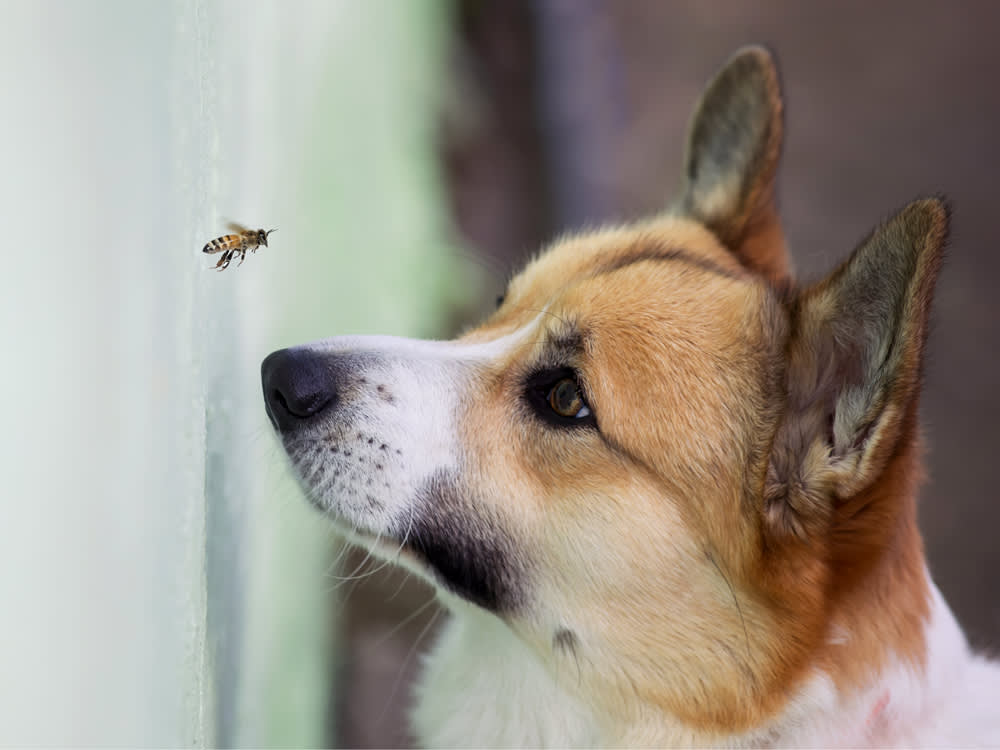What to Do If Your Dog Gets Stung By a Bee
From how to get the stinger out at home to when it’s time to go to the vet

share article
Taking a walk outside on a lovely day might be a nice idea, but stopping to smell the roses increases your dog’s chances of getting stung by a bee. I kicked off my Saturday morning shift at the vets by treating the cutest puffy-faced dog who experienced his first acute allergic reaction. In my experience, most pet parents won’t even notice that their pup has suffered a bee sting, which is why there’s so much bewilderment and concern when their dog’s mouth blows up like a balloon. Below, find a guide for what to do if your dog accidentally bites a bee, how to remove a stinger and when to see a vet.
How to know when your dog is stung by a bee
When a bee stings a dog, it usually results in an acute allergic reactionopens in a new tab, a common veterinary emergency. The typical culprits that bite and sting dogs are bees, wasps and spiders. Pet parents may not always know when their animal has been stung since bees are the only insects that actually leave stingers behind. Because they are curious sniffers and use their mouths to explore their environment, dogs are usually stung on their mouths, faces and paws but stings can occur anywhere on their bodies.
Your dog might be sniffing a fellow dog‘s wee spot amongst some flowers or maybe they just see an insect and try to catch it – or even eat it – getting a nasty sting in the process. If your dog swallows a bee or gets stung inside the mouth, it can be difficult to detect the stinger, so it’s crucial to watch for symptoms such as difficulty breathing, vomiting, weakness, pale gums or collapse and take your dog to a vet immediately.
Symptoms of a dog bee sting or insect bite
Dogs who are stung or bitten can experience everything from mild to life-threatening reactions depending on if they have a severe allergic reaction to the toxin. If there are any signs of facial swelling, vomiting, breathing difficulty or collapse, have your dog examined by a veterinarian immediately. Mild clinical signs can quickly become severe and early treatment will generally prevent continued progression of the reaction.
Mild reaction symptoms of a dog bee sting or insect bite:
swollen or puffy face
pain in the swollen area
swelling around the eyes
redness around the eyes
lumps and bumps over the skin
redness of the skin
head shaking
itchiness
Anaphylactic reaction symptoms of a dog bee sting or insect bite
Just like humans, dogs can be allergic to bee stings. Research shows that approximately 1-5 percent of people have a severe allergy to bees, but there isn’t any data on the prevalence in dogs. If a dog is allergic to bees, they can experience more severe symptoms – called an anaphylactic reaction – after a bee sting. Anaphylactic symptoms develop within minutes after a sting and can be life-threatening. Symptoms of an anaphylactic reaction to bee stings include:
facial swelling
severe itching
hives
collapse
staggering
pale gums
swelling of the larynx
difficulty breathing
difficulty swallowing
Most dogs that I see for anaphylaxis are reported to have vomited once followed by collapsing and when I perform a physical examopens in a new tab, I generally see pale gums and a poor pulse, indicating a state of shock.
What to do if your dog is stung by a bee or insect
You need to take your dog to the vet if they have been stung by a bee and show any signs of an allergic reaction. While seeking medical care, you can also remember the A-Bee-Cs of bites and stings:
A is for assist
When a honeybee stings a dog, its stinger becomes detached from its body and the bee dies. What’s left in the dog is the stinger and a tiny piece of fleshy-looking tissue, the venom sac. Wasps or bumblebees, on the other hand, can sting repeatedly because their stingers do not detach.
If your pet was stung, try to locate a stinger. If there is one, try to remove it by scraping it out with a credit card or plucking it out with tweezers. Be careful not to put pressure on the venom sac during its removal, as this will inject more venom into your dog. If you don’t feel confident in removing the stinger, wait until your veterinarian can do it.
If your dog has been stung by a bee and you can’t find the stinger, the stinger may have already fallen out or be located in an area that is difficult to see. Once you get to the vet, inform them of the possible stinger location so they can do a closer inspection.
B is for baking soda
To help neutralise some of the acidic venom, apply a paste of baking soda mixed with water to the sting area.
C is for cool compress
Apply a cool compress to the area to help reduce swelling and pain. This will also help constrict the blood vessels, thereby ‘slowing’ the spread of venom.
Can anaphylaxis be prevented?
The primary way to prevent anaphylaxis is to avoid stings. In general, there is no way to predict if a dog will have an allergic reaction to a bee sting or whether it will be mild or severe. Some dogs have no reaction to an initial sting and a severe reaction to the next.
Avoid areas with bees
When outside with your dog, keep an eye out for foraging bees on flowers, swarms of bees, and beehives. Keep pets from investigating under porches, houses, shrubbery, or known locations of nests/hives.
Watch for other insects
Dogs should also be wary of wasp nests and burrows, which can be a source of multiple stings if a dog gets too close. A single sting may not seem like a big deal, but multiple stings or a single sting for an allergic dog can be life-threatening and potentially have long-term complications.
Can I give my dog an antihistamine?
Vets in the UK tend to recommend Piriton (chlorphenamine) at 4mg per dog per 8 hours. Please speak to your vet first and check this is safe for your dog.
Though insect stings are never pleasant – for dogs or humans – prompt veterinary care can minimise the effects and ensure your dog has a safe, pleasant experience with the great outdoors.
Frequently asked questions
What do I do if my dog gets stung by a bee?
Try to locate and remove the stinger (be careful of the venom sac), neutralise the venom with a baking soda mix, apply a cool compress and contact your veterinarian immediately.
Do I need to take my dog to the vet if it is stung by a bee?
Yes, if your dog gets stung by a bee, you should take your dog to the veterinarian. Bee stings in dogs can result in mild to life-threatening symptoms, and there’s no way to predict your dog’s reaction.
Is a bee sting on a dog an emergency?
Bee stings in dogs are a common veterinary emergency because they usually result in an acute allergic reaction requiring veterinary attention.
How do I know if my dog got stung by something?
If you’re unsure if your dog was stung by a bee, look for symptoms such as swelling (especially around the face, throat, or paws), hives, difficulty breathing, vomiting, diarrhoea or collapsing, and seek immediate veterinary care.
How do you know if your dog was stung in the mouth?
If your dog is stung inside their mouth or swallowed a bee, they may experience symptoms such as swelling, coughing, drooling, rapid breathing, vomiting, and diarrhoea – seek immediate veterinary care.
References

Dr. Shea Cox, DVM, CVPP, CHPV
Dr. Shea Cox is the founder of BluePearl Pet Hospice and is a global leader in animal hospice and palliative care. With a focus on technology, innovation and education, her efforts are changing the end-of-life landscape in veterinary medicine.
Related articles
![Avoid heat stroke in dogs by sprinkling in the backyard with your dog]() opens in a new tab
opens in a new tabHeat–Stroke in Dogs: Signs, Treatment & Prevention Expert Advice
How to take precautions for your pup when temperatures rise
![Cute weimaraner dog lying on lawn and scratching its back]() opens in a new tab
opens in a new tab5 of the Best Ways to Solve Your Dog’s Allergies
Here’s what works (and what doesn’t)
![Woman holding a beagle in warm dappled summer light]() opens in a new tab
opens in a new tabYou’ve Got a Summer-Lovin’ Pup. Here’s How to Keep Them Safe
Some like it hot (but not most dogs). Here are the season’s health hazards, from fleas to grass seeds
![Dog near a vegetable garden next to a basket full of a harvest]() opens in a new tab
opens in a new tabTips on Dog-Safe Gardening
Garden organically, for the sake of both the planet and your dogs
![puppy scratching fleas, get rid of fleas on dogs]() opens in a new tab
opens in a new tabHome Remedies for Getting Rid of Fleas on Dogs – Naturally
How to stop your home from becoming a flea circus





